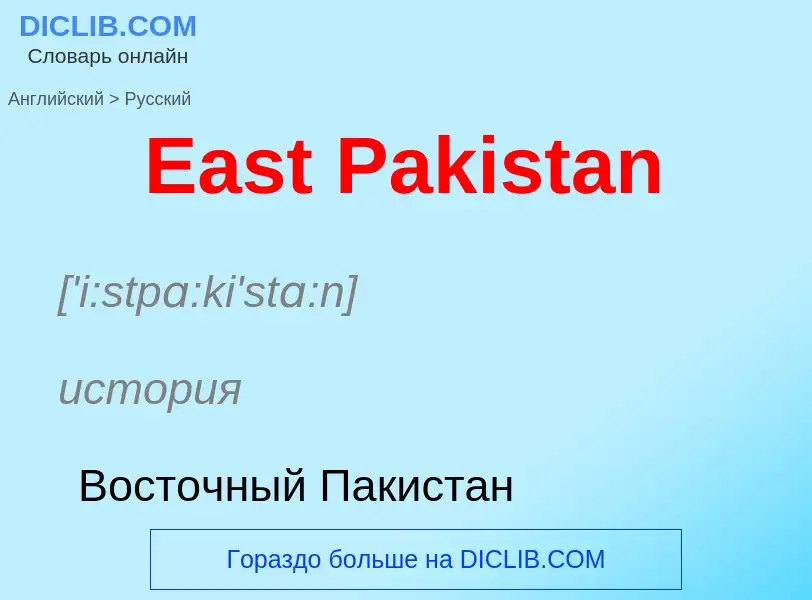ترجمة وتحليل الكلمات عن طريق الذكاء الاصطناعي ChatGPT
في هذه الصفحة يمكنك الحصول على تحليل مفصل لكلمة أو عبارة باستخدام أفضل تقنيات الذكاء الاصطناعي المتوفرة اليوم:
- كيف يتم استخدام الكلمة في اللغة
- تردد الكلمة
- ما إذا كانت الكلمة تستخدم في كثير من الأحيان في اللغة المنطوقة أو المكتوبة
- خيارات الترجمة إلى الروسية أو الإسبانية، على التوالي
- أمثلة على استخدام الكلمة (عدة عبارات مع الترجمة)
- أصل الكلمة
East Pakistan - ترجمة إلى الروسية
['i:stpɑ:ki'stɑ:n]
история
Восточный Пакистан
[pɑ:ki'stɑ:n]
существительное
география
Пакистан
تعريف
ويكيبيديا
East Pakistan was a Pakistani province, established in 1955 under the One Unit Policy, renaming and restructuring the province as such from East Bengal, which, in modern times, is split between India and Bangladesh. Its land borders were with India and Myanmar, with a coastline on the Bay of Bengal. East Pakistanis were popularly known as "Pakistani Bengalis"; to distinguish this region from India's state West Bengal (which is also known as "Indian Bengal"), East Pakistan was known as "Pakistani Bengal". In 1971, East Pakistan became the newly independent state Bangladesh, which means "country of Bengal" in Bengali.
East Pakistan was renamed from East Bengal by the One Unit Scheme of Pakistani Prime Minister Mohammad Ali of Bogra. The Constitution of Pakistan of 1956 replaced the Pakistani monarchy with an Islamic republic. Bengali politician H. S. Suhrawardy served as the Prime Minister of Pakistan between 1956 and 1957 and a Bengali bureaucrat Iskander Mirza became the first President of Pakistan. The 1958 Pakistani coup d'état brought general Ayub Khan to power. Khan replaced Mirza as president and launched a crackdown against pro-democracy leaders. Khan enacted the Constitution of Pakistan of 1962 which ended universal suffrage. By 1966, Sheikh Mujibur Rahman emerged as the preeminent opposition leader in Pakistan and launched the six-point movement for autonomy and democracy. The 1969 uprising in East Pakistan contributed to Ayub Khan's overthrow. Another general, Yahya Khan, usurped the presidency and enacted martial law. In 1970, Yahya Khan organised Pakistan's first federal general election. The Awami League emerged as the single largest party, followed by the Pakistan Peoples Party. The military junta stalled in accepting the results, leading to civil disobedience, the Bangladesh Liberation War, 1971 Bangladesh genocide and Bihari genocide. East Pakistan seceded with the help of India.
The East Pakistan Provincial Assembly was the legislative body of the territory.
Due to the strategic importance of East Pakistan, the Pakistani union was a member of the Southeast Asia Treaty Organization. The economy of East Pakistan grew at an average of 2.6% between 1960 and 1965. The federal government invested more funds and foreign aid in West Pakistan, even though East Pakistan generated a major share of exports. However, President Ayub Khan did implement significant industrialisation in East Pakistan. The Kaptai Dam was built in 1965. The Eastern Refinery was established in Chittagong. Dacca was declared as the second capital of Pakistan and planned as the home of the national parliament. The government recruited American architect Louis Kahn to design the national assembly complex in Dacca.


![Entrance to the [[Adamjee Jute Mills]], the world's largest jute processing plant, in 1950 Entrance to the [[Adamjee Jute Mills]], the world's largest jute processing plant, in 1950](https://commons.wikimedia.org/wiki/Special:FilePath/Adamjee Jute Mills Entrance 1950.gif?width=200)
![President Ayub Khan (left) with Bengali industrialist [[Abul Kashem Khan]] (right) in Chittagong President Ayub Khan (left) with Bengali industrialist [[Abul Kashem Khan]] (right) in Chittagong](https://commons.wikimedia.org/wiki/Special:FilePath/Ayub Khan & A K Khan.jpg?width=200)
![Suhrawardy (middle) with US President [[Dwight D. Eisenhower]] and Secretary of State [[John Foster Dulles]] Suhrawardy (middle) with US President [[Dwight D. Eisenhower]] and Secretary of State [[John Foster Dulles]]](https://commons.wikimedia.org/wiki/Special:FilePath/HSS and Eisenhower.jpg?width=200)
![U.S. Army]], c. 1960. U.S. Army]], c. 1960.](https://commons.wikimedia.org/wiki/Special:FilePath/India Bangladesh border US Army Map Service.jpg?width=200)
![The [[Kaptai Dam]] in 1965 The [[Kaptai Dam]] in 1965](https://commons.wikimedia.org/wiki/Special:FilePath/Kaptai Dam 1965.jpg?width=200)
![[[Elizabeth II]], seen here visiting Chittagong in 1961, was Pakistan's Queen until 1956. [[Elizabeth II]], seen here visiting Chittagong in 1961, was Pakistan's Queen until 1956.](https://commons.wikimedia.org/wiki/Special:FilePath/Queenelizabeth-chittagongG1.jpg?width=200)
![[[Sheikh Mujibur Rahman]] announcing the Six Points [[Sheikh Mujibur Rahman]] announcing the Six Points](https://commons.wikimedia.org/wiki/Special:FilePath/Sheikh Mujibur Rahman Announcing 6 Points At Lahore.jpg?width=200)
![Tofazzal Hossain]] was the leading Bengali newspaper in Pakistan Tofazzal Hossain]] was the leading Bengali newspaper in Pakistan](https://commons.wikimedia.org/wiki/Special:FilePath/TheDailyIttefaq.png?width=200)
![Third president of Pakistan, [[Yahya Khan]] with [[Richard Nixon]] in 1970 Third president of Pakistan, [[Yahya Khan]] with [[Richard Nixon]] in 1970](https://commons.wikimedia.org/wiki/Special:FilePath/Yahya and Nixon.jpg?width=200)
![[[Zulfikar Ali Bhutto]] in 1971 [[Zulfikar Ali Bhutto]] in 1971](https://commons.wikimedia.org/wiki/Special:FilePath/Zulfikar Ali Bhutto 1971.jpg?width=200)



![Bengali script]] until 1971 Bengali script]] until 1971](https://commons.wikimedia.org/wiki/Special:FilePath/Pakistani rupee pre-1971.jpg?width=200)
![A poster of the [[East Pakistan Helicopter Service]] A poster of the [[East Pakistan Helicopter Service]]](https://commons.wikimedia.org/wiki/Special:FilePath/East Pakistan helicopter poster.jpg?width=200)
